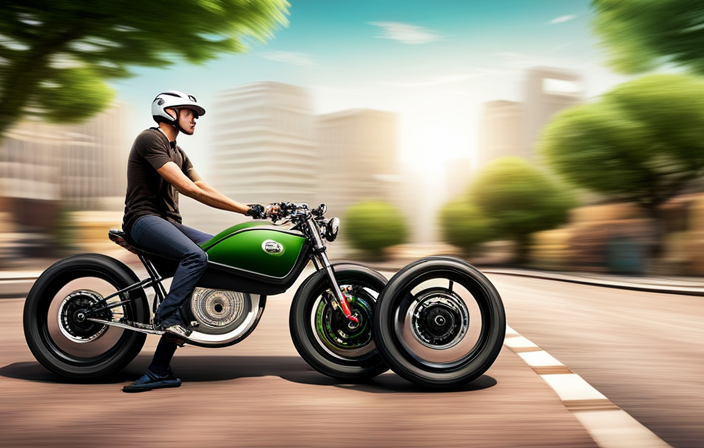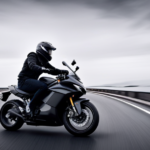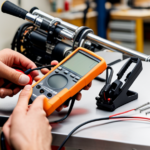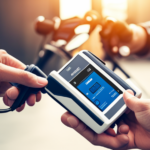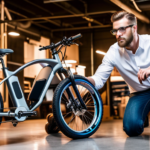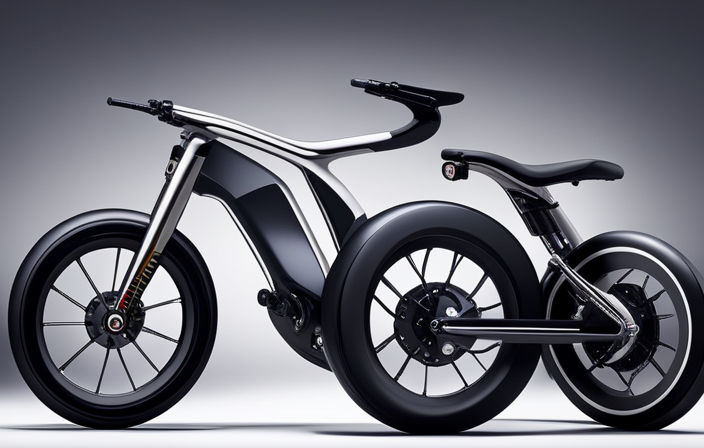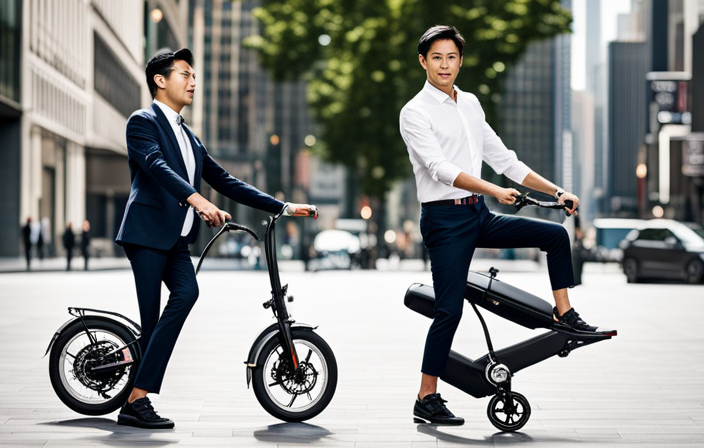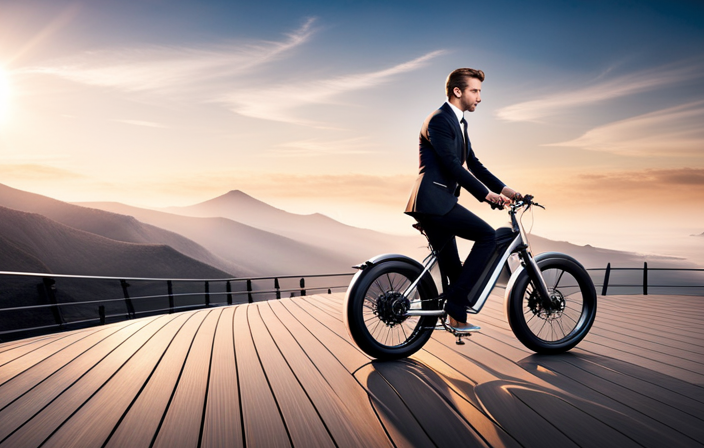As an avid electric bike enthusiast, I’ve come to rely on the smooth and effortless rides that my trusty two-wheeler provides.
However, there’s one vital component that can throw a wrench in my cycling bliss: the controller. Like the conductor of an orchestra, the controller orchestrates the flow of power to the motor, ensuring a seamless ride.
But what happens when this crucial component goes bad?
In this article, we’ll explore the signs, causes, and solutions for a faulty electric bike controller, so you can get back on the road in no time.
Key Takeaways
- Regular maintenance is important for preventing issues with the electric bike controller.
- Signs of a faulty controller include loss of power, inconsistent speed, error codes, and strange sounds.
- Common causes of controller malfunctions include faulty connections, water damage, overheating, and software glitches.
- Troubleshooting steps include checking battery connection, inspecting throttle and motor, and testing with a different controller.
What is an Electric Bike Controller?
The electric bike controller is responsible for regulating the power output of the motor. It is a crucial component that ensures smooth and efficient operation of the electric bike. Understanding how the controller works and knowing how to troubleshoot common issues is essential for maintaining the performance of your electric bike.
Electric bike controller troubleshooting involves identifying and resolving problems that may arise with the controller. Regular maintenance is important to prevent issues from occurring in the first place. This includes keeping the controller clean and dry, checking the wiring connections regularly, and inspecting for any signs of damage or wear.
Regular maintenance is important because a faulty controller can cause a range of issues, such as decreased power output, erratic motor behavior, or complete motor failure. These problems can greatly impact the performance and safety of your electric bike. By performing regular maintenance and addressing any issues promptly, you can ensure that your electric bike controller operates smoothly and reliably.
Transition: Now that we understand the importance of regular maintenance for the electric bike controller, let’s explore the common signs and symptoms of a faulty controller.
Common Signs and Symptoms of a Faulty Controller
One of the most common signs that your controller is faulty is when it stops responding to your inputs. This can be frustrating and inconvenient, especially if you rely on your electric bike for transportation. However, it is important to recognize other signs and symptoms that may indicate a faulty controller. Here are some common signs to look out for:
| Signs and Symptoms | Description |
|---|---|
| Loss of power | Your electric bike may experience a sudden loss of power, making it difficult to ride uphill or at higher speeds. |
| Inconsistent speed | Your bike may fluctuate in speed, going faster or slower than usual without any input from you. |
| Error codes | Some electric bikes have error codes that can be displayed on the controller. These codes can indicate specific issues with the controller. |
| Strange noises | If you hear unusual buzzing, clicking, or whirring sounds coming from the controller, it could be a sign of a malfunction. |
| Overheating | A faulty controller may become excessively hot during use, which can lead to further damage if not addressed. |
Recognizing these signs and symptoms can help you identify a faulty controller and take appropriate action. Now, let’s explore the potential causes of controller malfunctions without skipping a beat.
Potential Causes of Controller Malfunctions
To understand why your controller may be malfunctioning, it’s important to look at the potential causes of these issues. Diagnosing controller issues and troubleshooting controller problems can be a complex task, but by examining the common culprits, you can narrow down the possibilities.
One possible cause of controller malfunctions is a faulty connection. Loose or damaged wires can disrupt the flow of electricity, leading to erratic behavior or complete failure of the controller.
Another potential issue is water damage. Exposure to moisture can corrode the internal components of the controller, causing it to malfunction.
Additionally, overheating can be a factor in controller problems. If the controller gets too hot, it may shut down or exhibit strange behavior. This can be caused by improper ventilation or prolonged use without breaks.
Lastly, software or firmware glitches can also cause controller malfunctions. Updates or changes to the programming can introduce bugs or conflicts, leading to issues with the controller’s performance.
Diagnosing the Issue
If you’re experiencing issues with your controller, it’s crucial to begin diagnosing the problem. Troubleshooting techniques can help identify common controller problems and determine the best steps to resolve the issue.
One common problem is a non-responsive controller. In this case, check the battery connection and ensure it is securely plugged in. If the connection is loose, tighten it and test the controller again.
Another issue could be a faulty throttle. To diagnose this, inspect the throttle for any visible damage or loose connections. If the throttle appears to be in good condition, try replacing it with a known working throttle to see if that resolves the problem.
Additionally, a malfunctioning motor can also cause controller issues. Inspect the motor for any signs of damage or overheating. If the motor seems fine, consider testing it with a different controller to determine if the issue lies with the motor or the controller itself.
Steps to Resolve the Issue
Once you have diagnosed the issue with your controller, you can proceed with the necessary steps to resolve it. Troubleshooting techniques can help you identify common controller issues and address them effectively.
One common problem is a faulty connection. Start by checking all the wiring connections to ensure they are secure and properly connected. If you find any loose or damaged wires, repair or replace them accordingly.
Another issue could be a malfunctioning throttle. Test the throttle by disconnecting it from the controller and using a multimeter to check for proper voltage output. If the throttle is not functioning correctly, it may need to be replaced.
Additionally, a damaged or worn-out controller can cause problems. In such cases, replacing the controller might be necessary. Remember to choose a controller that is compatible with your electric bike.
By following these troubleshooting techniques, you can successfully resolve common controller issues and get your electric bike up and running smoothly again.
To prevent future controller issues, it is essential to take some preventive measures.
Preventive Measures to Avoid Controller Issues
One way you can avoid future issues with your controller is by regularly inspecting the wiring connections for any signs of damage or looseness. This is of utmost importance when it comes to the regular maintenance of electric bikes. By keeping a close eye on the wiring connections, you can prevent any potential problems before they occur. It is crucial to ensure that the connections are secure and free from any frayed wires or loose connections. This will help in maintaining the overall functionality and performance of your electric bike.
Another aspect of regular maintenance is choosing the right controller for your electric bike. The controller plays a vital role in regulating the power output and performance of the motor. It is essential to select a controller that is compatible with your bike’s specifications and requirements. Consider factors such as voltage, current rating, and programming options when choosing a controller. This will ensure optimal performance and longevity for your electric bike.
Seeking Professional Help and Repairs
When facing issues with an electric bike, there are several options for seeking professional help and repairs.
First, I recommend contacting the manufacturer or retailer directly for assistance. They can provide valuable insight and guidance on how to address the problem.
Additionally, consulting an electric bike technician can offer specialized expertise and ensure that the issue is properly diagnosed and resolved.
Lastly, joining online forums or communities dedicated to electric bikes can provide a wealth of advice and support from fellow enthusiasts who have encountered similar challenges.
Contacting the Manufacturer or Retailer
If the controller on your electric bike goes bad, you should contact the manufacturer or retailer for assistance. It is important to reach out to them as soon as possible to ensure a timely resolution.
Start by contacting their customer support department, either through phone or email, and explain the issue you are experiencing with the controller. They may ask for some additional information or troubleshooting steps to narrow down the problem.
In some cases, they may offer a warranty or repair service to fix or replace the faulty controller. If you are not satisfied with their response or if they are unresponsive, you may consider exploring legal options, such as filing a complaint or seeking compensation.
However, before taking any legal action, it is advisable to consult an electric bike technician to further assess the issue and gather evidence if necessary.
Consulting an Electric Bike Technician
To get a professional opinion on the issue, you should consider consulting an electric bike technician. Electric bike modifications can sometimes lead to problems with the bike’s controller.
A technician can help troubleshoot common electric bike issues and diagnose if the controller is the culprit. They have the knowledge and expertise to thoroughly inspect the controller and determine if it needs to be repaired or replaced. They can also guide you on the best course of action, whether it’s a simple fix or a more complex issue.
Joining Online Forums or Communities for Advice
Joining online forums or communities is a great way to connect with experienced individuals who can offer advice on your specific issue. When it comes to electric bikes, seeking professional help is crucial, especially if you’re facing problems with your controller.
Here are three reasons why joining online forums can be beneficial:
-
Access to a wide range of expertise: Online communities bring together electric bike enthusiasts, technicians, and manufacturers who have extensive knowledge about different controller issues.
-
Real-life experiences: Members of online forums often share their own experiences with controller problems and repairs, providing valuable insights and tips.
-
Community support: Being part of an online community allows you to connect with like-minded individuals who can offer emotional support and encouragement throughout your repair journey.
By actively participating in these forums, you can gain valuable advice and guidance on how to handle a faulty controller.
Now, let’s delve into understanding warranty coverage and repair options for your electric bike.
Understanding Warranty Coverage and Repair Options
When it comes to understanding warranty coverage and repair options for electric bikes, it’s important to familiarize oneself with the manufacturer’s warranty terms and conditions. These terms and conditions outline the specific coverage and limitations provided by the manufacturer, such as the duration of the warranty and what types of repairs are included.
Additionally, consumers may have the option to purchase an extended warranty or third-party coverage for added protection.
Lastly, one must consider whether to attempt DIY repairs or opt for professional repairs, weighing the benefits of cost savings versus the potential risks of voiding the warranty or causing further damage.
Manufacturer’s Warranty Terms and Conditions
If your electric bike’s controller goes bad, you should familiarize yourself with the manufacturer’s warranty terms and conditions. This will help you understand what options are available to you in terms of repair or replacement. Here are three key points to consider:
-
Manufacturer’s Response: The manufacturer may have specific guidelines on how to handle a faulty controller. It is important to follow these guidelines to ensure that you receive the appropriate support and service from the manufacturer.
-
Customer Reviews: It can be helpful to read customer reviews to get an idea of how the manufacturer has responded to similar issues in the past. This can give you an indication of their level of customer service and how they handle warranty claims.
-
Warranty Coverage: Take note of the duration and extent of the warranty coverage for the controller. Some warranties may only cover certain parts or have limitations on the repair or replacement process. Understanding these terms and conditions will help you make informed decisions about your options.
Extended Warranty or Third-Party Coverage
When it comes to protecting my electric bike, I have found that exploring additional coverage options beyond the manufacturer’s warranty can be a wise decision.
One such option is an extended warranty or third-party insurance. These types of coverage provide an extra layer of protection for my electric bike’s components, including the controller.
Extended warranties offer benefits such as coverage for repairs and replacements, even after the manufacturer’s warranty expires. Third-party insurance can also provide peace of mind by covering unforeseen damages or accidents.
By investing in these types of coverage, I can ensure that my electric bike’s controller, among other components, is protected for an extended period.
Now, let’s delve into the next section and examine the pros and cons of DIY repairs versus professional repairs.
DIY Repairs vs. Professional Repairs
You’ll find that deciding whether to tackle repairs yourself or seek professional help is a crucial aspect of maintaining your electric bike. When it comes to DIY repairs versus professional repairs, there are several factors to consider.
Here are some benefits of professional repairs over DIY repairs:
-
Expertise: Professionals have extensive knowledge and experience in dealing with electric bike repairs. They can quickly diagnose and fix issues, ensuring the job is done correctly.
-
Quality Parts: Professionals have access to high-quality parts that may not be readily available to DIY enthusiasts. This ensures that your bike is repaired with parts that are specifically designed for optimal performance.
-
Warranty: Professional repairs often come with warranties, providing you with added peace of mind knowing that if anything goes wrong, you’re covered.
Transitioning into the subsequent section about ‘resources for electric bike parts and accessories,’ it is important to have access to reliable sources for all your repair and accessory needs.
Resources for Electric Bike Parts and Accessories
Looking for resources to find electric bike parts and accessories?
When it comes to electric bike maintenance, having access to reliable parts and accessories is essential. Whether you need to replace a worn-out component or upgrade your electric bike, knowing where to find high-quality parts is crucial.
One important aspect of electric bike maintenance is choosing the right electric bike battery. A good battery not only provides sufficient power but also ensures a longer lifespan for your electric bike.
When looking for electric bike parts and accessories, I recommend starting with reputable online retailers that specialize in electric bike components. These retailers often have a wide selection of parts and accessories, including batteries, motors, controllers, and more.
Additionally, local bike shops may also carry electric bike parts and accessories or be able to order them for you. It’s important to do your research and compare prices, warranties, and customer reviews to ensure you’re getting the best quality parts for your electric bike.
Conclusion and Final Thoughts
In conclusion, it’s crucial to find reliable resources for electric bike parts and accessories to ensure proper maintenance and upgrades. When it comes to electric bike maintenance, having access to high-quality parts and accessories is essential.
Here are some troubleshooting tips to keep your electric bike running smoothly:
- Regularly inspect and clean the battery connections to prevent corrosion and ensure a secure connection.
- Pay attention to any unusual sounds or vibrations coming from the motor, as this may indicate a problem with the controller.
- Check the wiring connections to the controller to ensure they are secure and free from any damage.
- If your electric bike suddenly loses power or experiences a decrease in performance, it may be a sign of a faulty controller.
- It’s important to consult the manufacturer’s manual or seek professional assistance if you suspect a problem with the controller, as attempting to repair it yourself may void the warranty.
Frequently Asked Questions
How long does an electric bike controller typically last before it goes bad?
Electric bike controllers typically last for several years before they go bad. Common causes of failure include water damage, overheating, and electrical shorts. To troubleshoot a faulty controller, check for loose connections, test the power output, and consider seeking professional assistance.
Can a faulty controller cause other components of the electric bike to malfunction?
A faulty controller can have a significant impact on an electric bike’s performance. It can cause other components to malfunction, leading to potential risks and dangers while riding. It’s crucial to address controller issues promptly to ensure safe and efficient operation.
Are there any warning signs or indicators that can help identify a faulty controller before it completely stops working?
Warning signs of a faulty controller include inconsistent power delivery, sudden loss of power, and error messages on the display. Troubleshooting steps may involve checking connections, testing the battery, and inspecting the controller for physical damage or overheating.
Can a DIY enthusiast with limited technical knowledge repair or replace a faulty electric bike controller?
As a DIY enthusiast with limited technical knowledge, troubleshooting and repairing a faulty electric bike controller can be challenging. It requires a thorough understanding of the system and specialized tools. Seek professional assistance for a successful repair or replacement.
Are there any specific maintenance routines or checks that can help prolong the lifespan of an electric bike controller?
To prolong the lifespan of an electric bike controller, follow these maintenance tips: regularly inspect connections, keep the controller clean and dry, avoid overloading the system, and refer to the troubleshooting guide for any issues that may arise.
Conclusion
In conclusion, my fellow electric bike enthusiasts, when faced with a faulty controller, it’s as if the world has turned upside down. The once smooth ride becomes a chaotic mess, leaving us feeling lost and helpless.
But fear not! With the right knowledge and resources, you can conquer this electric beast. From diagnosing the issue to seeking professional help, we’ve covered it all.
Remember, knowledge is power, and with a bit of technical know-how, you’ll be back on the road in no time, leaving those controller malfunctions in the dust.
Keep riding, my friends!

